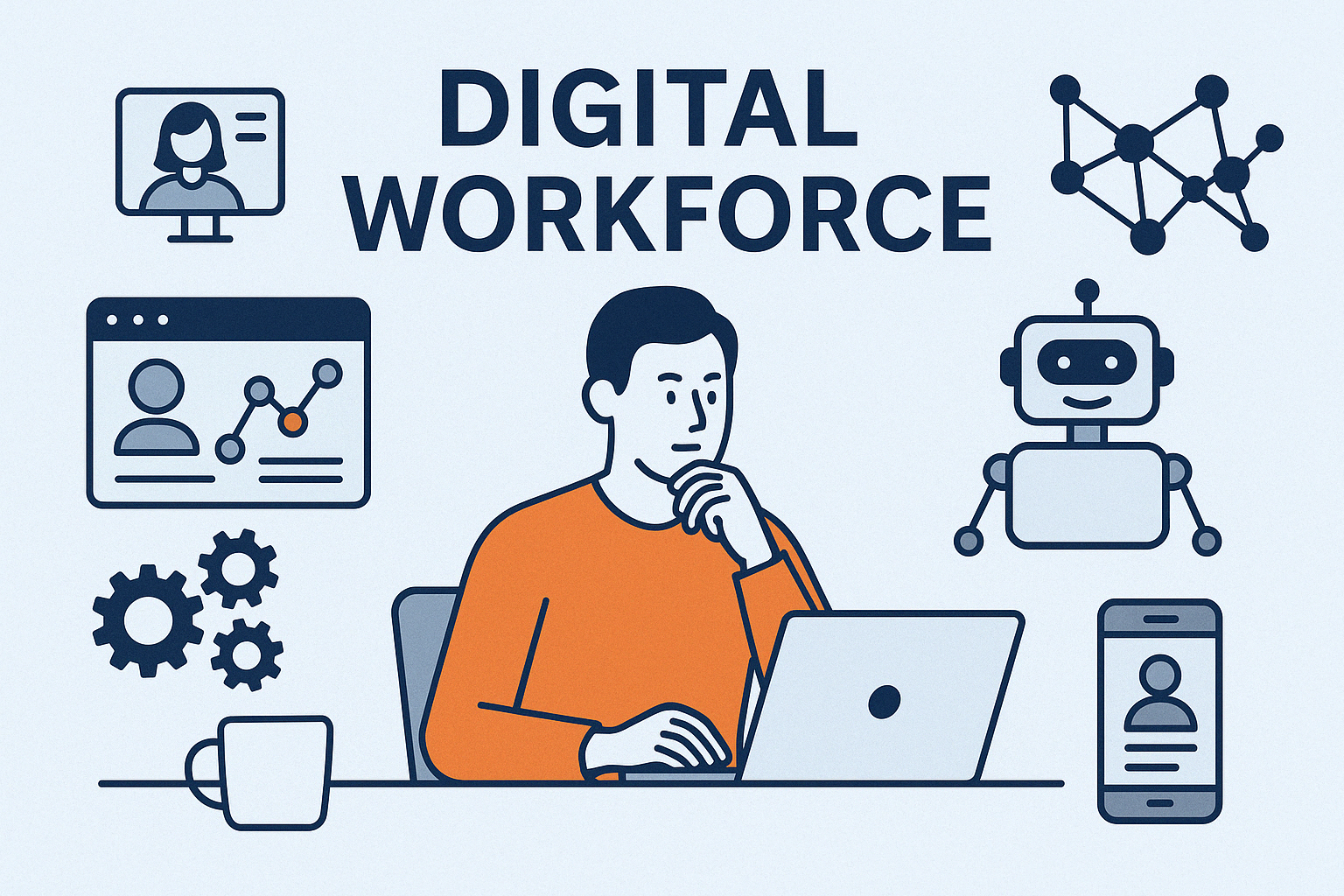Digital Workforce: Powering the Future of Work with People + Technology
What Is a Digital Workforce?
A Digital Workforce refers to the seamless integration of human talent and digital technologies—such as automation tools, AI, robotics, and cloud platforms—to execute business processes, drive innovation, and adapt to rapid change. It goes beyond simply using digital tools; a true digital workforce operates intelligently, collaboratively, and in real time, enabling organizations to stay agile, productive, and competitive.
In practice, the digital workforce is not a replacement for human workers—it’s an evolution. It transforms how people work, where they work, and how they collaborate with technology to create value.
Key Components of a Digital Workforce
At its core, a digital workforce includes a combination of human skills, digital tools, data systems, and AI-powered assistants. These components interact across every layer of the organization.
Human employees bring creativity, critical thinking, and empathy, while digital “workers”—including RPA bots, machine learning models, and generative AI systems—take over repetitive, rules-based, or data-heavy tasks.
Key enablers include:
Cloud-based collaboration tools (e.g., Microsoft Teams, Slack, Zoom)
Intelligent automation and RPA platforms
Generative AI tools for writing, analysis, or HR support
Applicant Tracking Systems (ATS) and AI Recruitment platforms
Performance Management Systems enhanced by AI
Learning Experience Platforms (LXP) for continuous upskilling
Together, these systems form a digital-first infrastructure that supports everything from remote work to real-time decision-making.
Why Building a Digital Workforce Matters
The future of work is hybrid, distributed, and dynamic. Organizations that embrace a digital workforce unlock significant competitive advantages:
Increased Efficiency
Digital tools automate repetitive processes, freeing up human employees to focus on complex, high-value tasks. Teams become leaner, faster, and more productive.
Real-Time Agility
Access to real-time data and collaboration systems empowers employees to respond instantly to market changes, customer needs, and project demands.
Scalable Talent Deployment
Through Talent Marketplaces and internal mobility platforms, employees can move fluidly across roles and projects, supported by AI recommendations and data-driven career paths.
Personalized Employee Experience
With AI-driven insights, organizations can deliver tailored feedback, learning, and support—boosting engagement, retention, and performance.
Resilience in Disruption
A digital workforce can rapidly transition to remote operations, adjust workflows, and continue delivering value even amid economic or environmental disruption.
The Human Side of the Digital Workforce
While technology is a core component, the digital workforce is ultimately about enabling people. Digital transformation must be human-centered, focusing on empowering employees rather than replacing them.
This means designing systems with:
User-friendly interfaces
Inclusive, bias-aware AI models
Accessible learning platforms
Clear communication and change management
Moreover, the shift to a digital workforce demands that employees themselves evolve. New roles and capabilities—such as data literacy, digital collaboration, and agile work habits—become essential. That’s why many organizations are investing in structured career pathing, skills taxonomies, and cross-functional learning initiatives to build internal capability.

The Role of HR in Shaping the Digital Workforce
HR plays a critical role in orchestrating this transformation. From digital onboarding and virtual learning to AI-driven talent acquisition and performance management, HR teams must lead the way in integrating people and platforms.
Key responsibilities include:
Redesigning jobs around human + machine collaboration
Curating AI-assisted tools for recruitment, coaching, and feedback
Building internal mobility frameworks that leverage digital insight
Creating a culture of continuous learning and experimentation
Forward-thinking HR leaders are positioning themselves as strategic partners—not only enabling tech adoption but ensuring it aligns with business goals, employee needs, and organizational values.
Trends Shaping the Digital Workforce
The digital workforce is evolving rapidly, driven by several key trends:
Generative AI at Scale
HR and business units are increasingly using large language models to generate content, analyze performance data, and enhance decision-making. Generative AI in HR is reshaping everything from onboarding to employer branding.
Hyperautomation
Combining RPA, AI, and API integration to streamline end-to-end business processes, not just individual tasks.
Digital Twins of the Organization (DTO)
Virtual models of workforce systems and processes help simulate change scenarios, optimize roles, and test reorganization strategies.
Self-Driven Employee Experiences
Employees expect consumer-grade experiences—customized, mobile, and AI-powered—across everything from learning to benefits.
Conclusion
The digital workforce is not just a tech trend—it’s a fundamental shift in how organizations operate, compete, and grow. By blending human creativity with digital intelligence, companies can unlock new levels of agility, resilience, and innovation.
But success depends not only on the tools deployed—but on the culture, leadership, and strategy that bring it all together.
In a world defined by change, organizations that invest in building a truly integrated digital workforce will be the ones best equipped for the future of work.
HR Glossary: Master the Language of Modern HR
From recruiting candidates to onboarding new team members, MokaHR gives your company everything you need to be great at hiring.
Subscribe for more information

